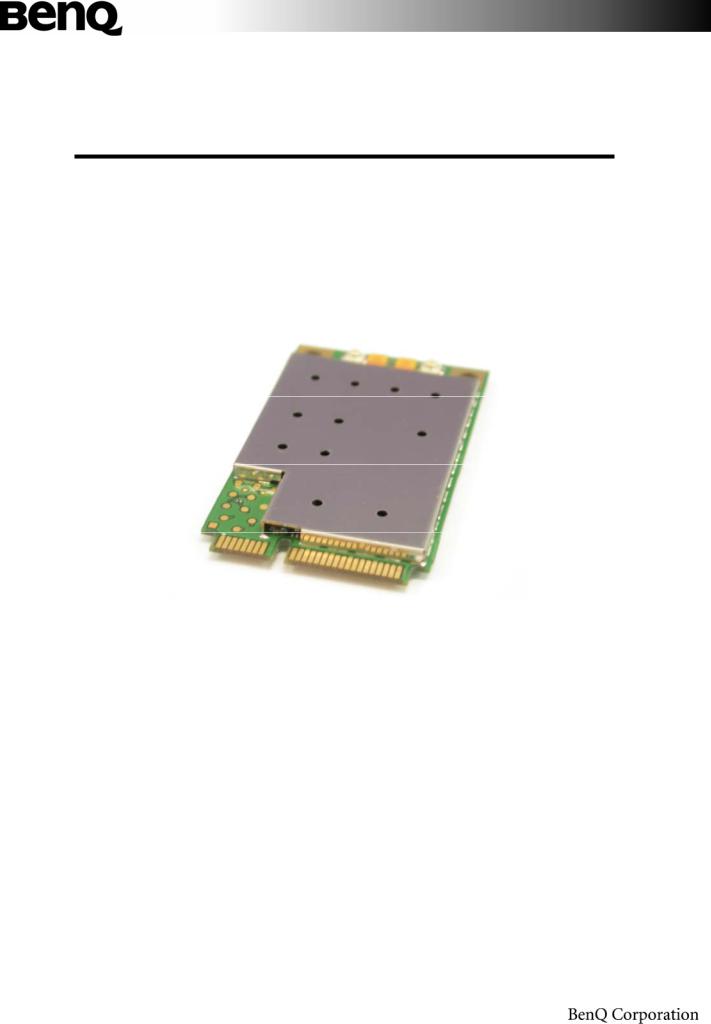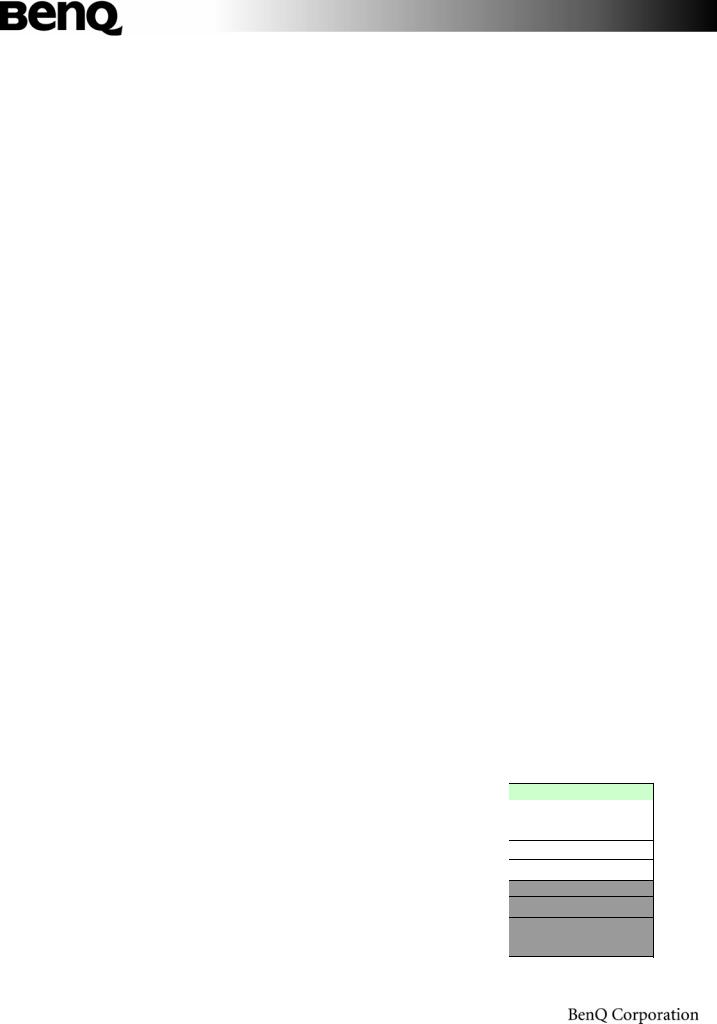Benq H10 Manual

Datasheet
H10 (Data-Only)
HSDPA PCI Express mini card module
Datasheet
Rev. 0.2 (Preliminary) 2007/06/22
COPYRIGHT BENQ Corporation
This document contains proprietary technical information which is the property of BenQ Corporation and is issued in strict confidential and shall not be disclosed to others parties in whole or in parts without written permission of BenQ Corporation
The documents contain information on a product, which is under development and is issued for customer evaluation purposes only.
BENQ may make changes to product specifications at any time, without notice.
1

BenQ Corporation
Mobile Communications BG
18 JiHu Road, Nei-Hu, Taipei 114, Taiwan, R.O.C.
Tel: +886-2-2799-8800
Fax: +886-2-2656-6390
http://www.BenQ.com
HISTORY
Version |
Date |
Notes |
|
|
|
VER: 0.1 |
2007-APR-24 |
FIRST RELEASE |
|
|
|
VER: 0.2 |
2007-JUN-22 |
Update characteristic of RF |
|
|
|
2

1. INTRODUCTION..................................................................................................... |
4 |
|
1.1 |
Description......................................................................................................... |
4 |
1.2 Application Device.............................................................................................. |
4 |
|
2. FEATURES ............................................................................................................... |
5 |
|
2.1 |
General Characteristics ....................................................................................... |
5 |
2.2 |
RF Functionalities............................................................................................... |
6 |
|
Maximum TX Power ........................................................................................ |
6 |
|
Parametric Performance ................................................................................... |
6 |
|
Sensitivity......................................................................................................... |
7 |
|
Radio Frequency............................................................................................... |
7 |
3. HARDWARE DESCRIPTION..................................................................................... |
9 |
|
3.1 |
System Interface.................................................................................................. |
9 |
3.2 Functional Diagram.......................................................................................... |
10 |
|
3.3 |
Pin Description................................................................................................. |
11 |
3.4 |
Terminal Definition .......................................................................................... |
13 |
3.5 |
Electrical Characteristics................................................................................... |
15 |
|
DC characteristics........................................................................................... |
15 |
|
Digital interface.............................................................................................. |
16 |
|
USB Transceiver DC characteristics................................................................. |
16 |
|
USIM Interface............................................................................................... |
17 |
3.6 Environmental.................................................................................................. |
17 |
|
3.7 |
Physical Package ............................................................................................... |
18 |
4. SOFTWARE CHARACTERISTICS ............................................................................ |
21 |
|
4.1 |
Introduction..................................................................................................... |
21 |
4.2 |
Software Architecture........................................................................................ |
21 |
5.1 Compliance with FCC Rules and Regulations |
|
|
3

1. INTRODUCTION
1.1 Descrip ion
Overview
This document describes all the functions, features, and interfaces of the HSDPA
PCI |
Express |
Mini |
Card |
Module |
-- H10 from BenQ. BenQ H10 |
|||||
HSDPA |
module |
supports |
Tri-band |
WCDMA/HSDPA and Quad-band |
||||||
GSM/GPRS/EDGE |
network connection capability. |
|||||||||
BenQ |
H10 |
HSDPA |
card |
can |
provides high speed data connection, and the |
|||||
data speed |
of |
downlink |
path |
is |
up |
to 7.2Mbps. Furthermore, users can |
||||
ease |
to |
use |
this module |
by |
using |
the |
“Qsyncher” application software that we |
|||
provide for Windows XP and Vista system.
With the BENQ H10 HSDPA module, devices are enhanced in both functionality and usability based on state of the art wireless technology.
1.2 Applica ion Device
Scope
BenQ H10 module is a high speed modem card with PCI Express minicard form factor and is focusing on the Notebook, UMPC, MID and other portable device marketing.
No ebook
Ul ra Mobile PC
Mobile In erne Device
Wireless Rou er
USB Modem
Car Embedded Sys em
4

2. FEATURES
2.1 General Charac eris ics
BAND:
GSM850/EGSM900/DCS1800/PCS1900/WCDMA850/WCDMA1900/WCDMA2100
Band |
TX |
RX |
GSM850 |
824~849 MHz |
869~894MHz |
|
|
|
EGSM900 |
880~915 MHz |
925~960MHz |
|
|
|
DCS1800 |
1710~1785MHz |
1805~1880MHz |
|
|
|
PCS1900 |
1850~1910MHz |
1930~1990MHz |
|
|
|
WCDMA850 |
824~849 MHz |
869~894MHz |
|
|
|
WCDMA1900 |
1850~1910MHz |
1930~1990MHz |
|
|
|
WCDMA2100 |
1920~1980MHz |
2110~2170MHz |
|
|
|
Support SIM Interface: 1.8V/3V
Form factor
i.Dimension: 50.95 x 30 x 5.0 mm
ii.Weight: 12g
Power
Operation Voltage: 3.3V +/- 9%
Power Consumption:
Speech Mode:
Band |
Typ |
Max |
Unit |
|
|
|
|
GSM850 / PCL=5 |
385 |
400 |
mA |
|
|
|
|
EGSM900 / PCL=5 |
395 |
410 |
mA |
|
|
|
|
DCS / PCL=0 |
312 |
325 |
mA |
|
|
|
|
PCS / PCL=0 |
280 |
295 |
mA |
|
|
|
|
WCDMA (all band) |
720 |
820 |
mA |
|
|
|
|
Standby Mode:
|
Typ (Average) |
Max (Average) |
Unit |
|
|
|
|
GSM / Page frame=2 |
3.5 |
4.5 |
mA |
|
|
|
|
GSM / Page frame=9 |
2.0 |
3 |
mA |
|
|
|
|
DCS / Page frame=2 |
3.5 |
4.5 |
mA |
|
|
|
|
DCS / Page frame=9 |
2.0 |
3 |
mA |
|
|
|
|
PCS / Page frame=2 |
3.5 |
4.5 |
mA |
|
|
|
|
PCS / Page frame=9 |
2.0 |
3 |
mA |
|
|
|
|
WCDMA / DRX=6 (0.64 S) |
3.6 |
4.5 |
mA |
|
|
|
|
WCDMA / DRX=9 (5.12 S) |
1.5 |
3 |
mA |
|
|
|
|
5

Hardware Interface:
52 Pins PCI Express Mini Card connector interface
2 RF Antenna Coaxial Connectors
Software Interface:
USB driver
Qsyncher software tool.
2.2 RF Func ionali ies
Maximum TX Power
The performance of the transmitter meets test requirement ETSI TS 151 010-1 chapter 13.3 for GSM, chapter 13.17.3 for EDGE and TS 34.121 chapter 5.2&5.4.3 for WCDMA, chapter 5.2A for HSDPA
Band |
Max |
Min |
GSM8S0 |
33 dBm ±2dBm |
S dBm ±SdBm |
|
|
|
EGSM |
33 dBm ±2dBm |
S dBm ±SdBm |
|
|
|
DCS |
30 dBm ±2dBm |
0 dBm ±SdBm |
|
|
|
PCS |
30 dBm ±2dBm |
0 dBm ±SdBm |
|
|
|
GSM8S0(EDGE) |
27 dBm ±3dBm |
S dBm ±SdBm |
|
|
|
EGSM(EDGE) |
27 dBm ±3dBm |
S dBm ±SdBm |
|
|
|
DCS(EDGE) |
26 dBm ±3dBm |
2 dBm ±SdBm |
|
|
|
PCS(EDGE) |
26 dBm ±3dBm |
2 dBm ±SdBm |
|
|
|
UMTS-2100 |
24 dBm +1/-3dBm |
Less than -S0dBm |
|
|
|
UMTS-1900 |
24 dBm +1/-3dBm |
Less than -S0dBm |
|
|
|
UMTS-8S0 |
24 dBm +1/-3dBm |
Less than -S0dBm |
|
|
|
1/1S βo/βd 12/1S (HS-DPCCH) |
24 dBm +1/-3dBm |
|
13/1S βo/βd 1S/8 (HS-DPCCH) |
23 dBm +2/-3dBm |
|
1S/7 βo/βd 1S/0 (HS-DPCCH) |
22 dBm +3/-3dBm |
|
|
|
|
Parame ric Performance
Tests |
carried out at |
-20ºC, 25ºC |
and |
60ºC for each voltage 3V, 3.3V |
and |
|
3.6V. |
The Measured |
Peak Phase, |
RMS |
Phase, frequency error, power |
|
level, |
and |
static sensitivity meets ETSI TS 151 010-1 chapter 13.1 for GSM and TS |
34.121 |
||||
chapter 5.13.1 for WCDMA, chapter 5.13.1A for HSDPA
Band (GSM) |
Peak Phase Error |
RMS Phase Error |
GSM8S0 |
<20° |
<S° |
|
|
|
EGSM |
<20° |
<S° |
|
|
|
DCS |
<20° |
<S° |
|
|
|
PCS |
<20° |
<S° |
|
|
|
Band (WCDMA) |
Error Vector Magnitude |
|
UMTS-2100(HS-DPCCH) |
<17.S% |
|
|
|
|
UMTS-1900(HS-DPCCH) |
<17.S% |
|
|
|
|
UMTS-8S0(HS-DPCCH) |
<17.S% |
|
|
|
|
6

Sensi ivi y
The performance of the receiver meets test requirement ETSI TS 151 010-1 chapter 14.2.1 for GSM, chapter 14.18.1 for EDGE and TS 34.121 chapter 6.2 for WCDMA.
Band |
Typical |
Min |
GSM8S0 |
-107 dBm |
-104 dBm |
|
|
|
EGSM |
-107 dBm |
-104 dBm |
|
|
|
DCS |
-107 dBm |
-103 dBm |
|
|
|
PCS |
-107 dBm |
-103 dBm |
|
|
|
EDGE(GMSK modulation) |
-107 dBm |
-104 dBm |
|
|
|
EDGE(8-PSK modulation) |
-104 dBm |
-102 dBm |
|
|
|
UMTS-2100(Primary) |
-109 dBm |
-106.7 dBm |
|
|
|
UMTS-2100(Secondary) |
-109 dBm |
N/A |
|
|
|
UMTS-1900 |
-107 dBm |
-104.7 dBm |
|
|
|
UMTS-8S0(Primary) |
-109 dBm |
-106.7 dBm |
|
|
|
UMTS-8S0(Secondary) |
-109 dBm |
N/A |
|
|
|
Radio Frequency
GSM850 (850 MHz)
Frequency Range |
TX 824-849 MHz; RX 869-894 MHz |
|
|
Channel Spacing |
200 KHz |
|
|
Number of Channels |
124 Carriers x 8 (TDMA) |
|
|
Modulation |
GMSK / 8-PSK |
|
|
Duplex Spacing |
4S MHz |
|
|
Frequency Stability |
+/- 0.1 ppm (Uplink TX) |
|
|
Power Output |
33 dBm Class 8 (2 W peak) – S dBm |
|
|
Output Impedance |
S0 Ohm |
|
|
Spurious Emission |
-36 dBm up to 1 GHz (< -30 dBm > 1 GHz) |
|
|
EGSM (900 MHz) |
|
Frequency Range |
TX 880-91S MHz; RX 92S-960 MHz |
|
|
Channel Spacing |
200 KHz |
|
|
Number of Channels |
124 Carriers x 8 (TDMA) |
|
|
Modulation |
GMSK / 8-PSK |
|
|
Duplex Spacing |
4S MHz |
|
|
Frequency Stability |
+/- 0.1 ppm (Uplink TX) |
|
|
Power Output |
33 dBm Class 8 (2 W peak) – S dBm |
|
|
Output Impedance |
S0 Ohm |
|
|
Spurious Emission |
-36 dBm up to 1 GHz (< -30 dBm > 1 GHz) |
|
|
DCS (1800 MHz) |
|
Frequency Range |
TX 1710-178S MHz; RX 180S-1880 MHz |
|
|
Channel Spacing |
200 KHz |
|
|
Number of Channels |
374 Carriers x 8 (TDMA) |
|
|
Modulation |
GMSK / 8-PSK |
|
|
Duplex Spacing |
9S MHz |
|
|
Frequency Stability |
+/- 0.1 ppm (Uplink TX) |
|
|
Power Output |
30 dBm – 0 dBm |
|
|
|
7 |
